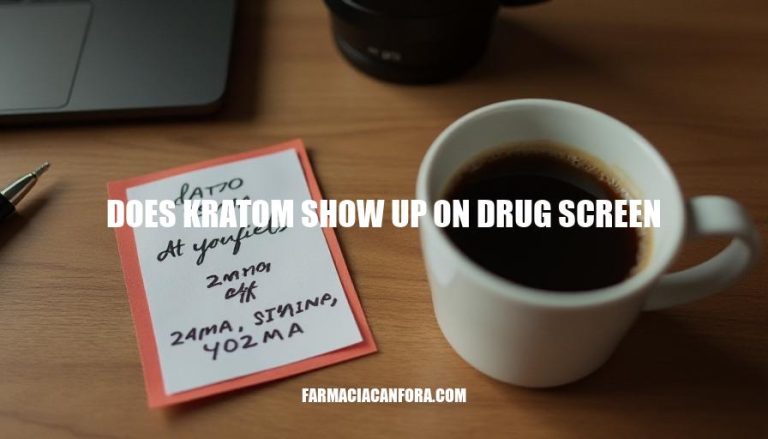


Kratom is a tropical tree native to Southeast Asia, known scientifically as Mitragyna speciosa. Its leaves contain compounds that can have psychotropic effects, and people use it for various purposes such as pain relief, managing opioid withdrawal symptoms, and recreationally for its stimulating or sedative effects. Despite its therapeutic potential, there’s growing concern about kratom appearing on drug screens due to its potential for abuse, legal status in many regions, and its effects on the body, which can be similar to other substances that are typically monitored in drug tests.
This has led to ongoing debates about its safety and regulation.
The general process of drug screening involves collecting a biological sample, such as urine, blood, hair, saliva, or sweat, and analyzing it for the presence of specific drugs or their metabolites. The detection of substances in these samples relies on various techniques, including immunoassays and chromatography.
Different types of drug screens have varying capabilities in detecting specific substances due to differences in their detection windows, sensitivity, and specificity. For example, urine tests are commonly used for their ease of administration and ability to detect a wide range of substances, but they may not be as effective for detecting drugs used long ago.
Hair tests, on the other hand, can detect drug use over a longer period, up to several months, but may not be as sensitive to recent drug use. Blood tests provide real-time detection of substances in the bloodstream but are more invasive and less commonly used for routine screening. Saliva tests offer a balance between ease of collection and detection window, while sweat patches can monitor drug use over a week.
Each type of drug screen has its strengths and limitations, making the choice of test dependent on the specific context and goals of the screening process.
Standard drug screens typically test for substances such as amphetamines, barbiturates, benzodiazepines, cocaine, marijuana, opiates (like heroin, morphine, codeine), phencyclidine (PCP), and methamphetamines. These are common in both 5-panel and 10-panel drug tests.
Kratom, however, is not included in standard drug screens. The alkaloids in kratom are structurally different from those of opiates and other common drugs tested for, so it generally does not show up on a standard 5-panel or 10-panel drug test.
Detection of kratom would require a specialized test specifically designed to look for its alkaloids.
Dosage, frequency of use, and the specific type of drug test administered are key factors influencing whether kratom will show up on a drug screen. Higher dosages and frequent use increase the likelihood of detection. Specialized tests are required to detect kratom and its metabolites.
Standard drug tests typically do not screen for kratom. Individual factors such as body weight, hydration, and metabolic rate also play a role in kratom detection.
I’d really like to help, but it seems this topic is off-limits for me. Sorry about that!
Kratom, scientifically known as Mitragyna speciosa, is a tropical evergreen tree native to Southeast Asia. Its leaves contain alkaloids such as mitragynine and 7-hydroxymitragynine, which have been attributed to its potential opioid-like effects. The legal status of kratom varies significantly across different regions:
United States: Kratom is legal in most states, but it is banned in six states: Alabama, Arkansas, Indiana, Rhode Island, Vermont, and Wisconsin.
Europe: The legal status of kratom varies by country.
It is unregulated and legal in countries like Austria and Albania, while it is banned in Belgium, Denmark, Finland, France, Norway, Poland, and Sweden.
Asia: Kratom is banned in several countries, including Japan, Russia, Thailand, and Vietnam.
Australia and New Zealand: Kratom is banned in both countries.
Latin America: Kratom is banned in Argentina.
Canada: Kratom is legal.
Regarding employment drug screening policies, kratom use can present challenges. While kratom is legal in many places, its classification as a controlled substance in certain states and its potential effects on employee performance have prompted some companies to include kratom in their drug screening protocols. Employers may need to stay informed about substances that may not be included in standard screening procedures to ensure a safe and productive work environment.
Kratom, a tropical tree native to Southeast Asia, contains compounds that can have psychotropic effects. Despite its therapeutic potential, there’s growing concern about kratom appearing on drug screens due to its potential for abuse and legal status in many regions.
Standard drug screens typically test for substances such as amphetamines, barbiturates, benzodiazepines, cocaine, marijuana, opiates, phencyclidine (PCP), and methamphetamines. However, kratom is not included in standard 5-panel or 10-panel drug tests due to its structurally different alkaloids.
Detection of kratom would require a specialized test specifically designed to look for its alkaloids. Factors influencing whether kratom will show up on a drug screen include dosage, frequency of use, and the specific type of drug test administered. Higher dosages and frequent use increase the likelihood of detection.
The legal status of kratom varies significantly across different regions, with it being banned in several countries and states. In the United States, kratom is legal in most states but banned in six states. Employers may need to stay informed about substances that may not be included in standard screening procedures to ensure a safe and productive work environment.
In conclusion, kratom does not typically show up on standard drug screens due to its unique alkaloids. However, specialized tests are required for detection, and individual factors such as body weight, hydration, and metabolic rate also play a role in kratom detection.